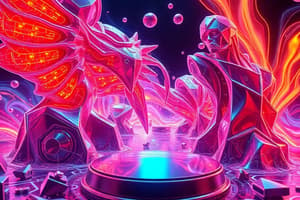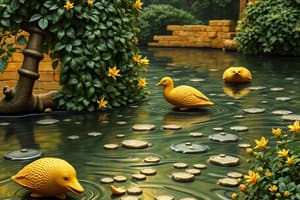Podcast
Questions and Answers
What does gloss provide to an object?
What does gloss provide to an object?
- A matte finish
- A transparent effect
- A glossy appearance (correct)
- A rough texture
What is specular reflection primarily concerned with?
What is specular reflection primarily concerned with?
- Absorption of light by the material
- Direct reflection of a light source (correct)
- Indirect light reflection
- Overall brightness of the object
Which characteristic should not be associated with objects other than light sources?
Which characteristic should not be associated with objects other than light sources?
- Subsurface Scattering
- Matte finish
- Luminosity/Emission (correct)
- Glossy appearance
What does subsurface scattering allow light to do?
What does subsurface scattering allow light to do?
Which of the following file types can be used for textures?
Which of the following file types can be used for textures?
What happens when applying a texture to a 3D model?
What happens when applying a texture to a 3D model?
Why can't a texture be applied to an item without a material?
Why can't a texture be applied to an item without a material?
What role do multiple textures play in video game terrain?
What role do multiple textures play in video game terrain?
What is the main advantage of procedural textures over bitmapped textures?
What is the main advantage of procedural textures over bitmapped textures?
Which of the following is NOT a type of noise commonly generated in procedural textures?
Which of the following is NOT a type of noise commonly generated in procedural textures?
What characterizes a gradient generator in procedural textures?
What characterizes a gradient generator in procedural textures?
How can procedural noise be utilized beyond static images?
How can procedural noise be utilized beyond static images?
Which term best describes the main characteristic of a procedural texture?
Which term best describes the main characteristic of a procedural texture?
Which one of the following represents a potential disadvantage of procedural textures?
Which one of the following represents a potential disadvantage of procedural textures?
What type of output is most commonly associated with procedural noise generators?
What type of output is most commonly associated with procedural noise generators?
In procedural textures, which component can influence the precision of the generated image?
In procedural textures, which component can influence the precision of the generated image?
What is the primary role of materials and textures in 3D design?
What is the primary role of materials and textures in 3D design?
Which property determines the RGB color of a material in 3D design?
Which property determines the RGB color of a material in 3D design?
How does the alpha/transparency setting affect a material?
How does the alpha/transparency setting affect a material?
What visual effect does refraction (IOR) create in 3D design?
What visual effect does refraction (IOR) create in 3D design?
Why are patterns and color variations important in the visualization of 3D models?
Why are patterns and color variations important in the visualization of 3D models?
What effect does the combination of different material properties have on a 3D object?
What effect does the combination of different material properties have on a 3D object?
Which of the following statements is true regarding materials in 3D design?
Which of the following statements is true regarding materials in 3D design?
In what way do materials aid in turning concepts into reality in 3D design?
In what way do materials aid in turning concepts into reality in 3D design?
What is the primary purpose of bump mapping in 3D graphics?
What is the primary purpose of bump mapping in 3D graphics?
Which of the following best describes a bump map?
Which of the following best describes a bump map?
Which mapping technique is typically NOT associated with bump mapping?
Which mapping technique is typically NOT associated with bump mapping?
What kind of details can bump mapping simulate on a 3D surface?
What kind of details can bump mapping simulate on a 3D surface?
Why is bump mapping preferred over increasing polygon count?
Why is bump mapping preferred over increasing polygon count?
Which characteristic defines traditional bump maps from other mapping types?
Which characteristic defines traditional bump maps from other mapping types?
How do bump maps affect the smoothness of a surface?
How do bump maps affect the smoothness of a surface?
What limitation do bump maps typically have in terms of color?
What limitation do bump maps typically have in terms of color?
What do black, white, and gray represent in a bump map?
What do black, white, and gray represent in a bump map?
What is a key advantage of normal maps over bump maps?
What is a key advantage of normal maps over bump maps?
What do normal maps create in 3D rendering?
What do normal maps create in 3D rendering?
Why have bump maps been generally phased out?
Why have bump maps been generally phased out?
What does the presence of gray in a bump map typically indicate?
What does the presence of gray in a bump map typically indicate?
Which statement about bump maps is true?
Which statement about bump maps is true?
What aspect makes normal maps a superior choice for 3D textures compared to bump maps?
What aspect makes normal maps a superior choice for 3D textures compared to bump maps?
Which of the following best describes bump maps?
Which of the following best describes bump maps?
Flashcards are hidden until you start studying
Study Notes
Materials & Textures in 3D Design
- Materials form the basis for a 3D object's appearance.
-
Materials include properties such as:
- Color (diffuse): The base color of an object influences its interaction with light. The diffuse color determines the perceived hue when light strikes and scatters, crucial for material appearance under varied lighting.
- Alpha/Transparency: The alpha parameter indicates an object's opacity or transparency, ranging from complete transparency to full opacity, creating visual effects like glass or water.
- Refraction (IOR): The Index of Refraction (IOR) measures light bending in materials, affecting visual realism, distortion, and edge light behavior..
- Gloss: Gloss describes a surface's shininess or matte quality and its reflectiveness, affecting highlight brightness and clarity.
- Specular: This refers to highlights from light reflecting on shiny surfaces, indicating material properties from polished to diffuse finishes.
- Reflection: Overall reflection indicates how surfaces reflect surroundings, enhancing realism and adding depth through light interaction..
- Luminosity/Emission: Emissive surfaces appear to emit light, simulating light sources and enhancing visual effects and depth.
- Subsurface Scattering: This feature is essential for materials like skin, wax, or leaves, as it simulates light penetration, enhancing realism and contributing to soft, lifelike edges.
Textures
- Textures are images applied to 3D objects to enhance realism.
- Textures can be various image file types (JPEG, PNG, TIFF).
- Textures are applied using mapping tools and work in conjunction with existing material settings.
Procedural Textures
- Procedural Textures are algorithmically generated textures, unlike image-based textures.
- They offer resolution independence and can create precise textures.
- Common types include:
- Noise Generators: Produce randomness (e.g., Fractal, Perlin, Marble)
- Gradient Generators: Create gradual color transitions (ramps)
Bump Mapping
- Bump Mapping adds surface detail (bumps, ridges, scratches) without increasing polygon count.
- Bump Maps create the illusion of depth and texture using grayscale images representing height information.
- Normal Maps are a more advanced version of bump maps that store both height and angle information.
Studying That Suits You
Use AI to generate personalized quizzes and flashcards to suit your learning preferences.





